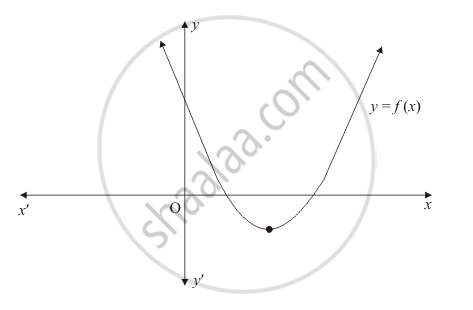Advertisements
Advertisements
प्रश्न
If a quadratic polynomial f(x) is not factorizable into linear factors, then it has no real zero. (True/False)
उत्तर
When polynomial `f(x)=ax^2 + bx + c` is not factorizable then the curve `y = ax^2 + bx + c` does not touch x-axis. Parabola `y = ax^2 + bx + c`open upwards above the x-axis or open downwards below x-axis where `a > 0` or `a < 0`
Hence, if quadratic polynomial ` f (x)` is not factorizable into linear factors then it has no real zeros. True.
APPEARS IN
संबंधित प्रश्न
If x = 3 is one root of the quadratic equation x2 – 2kx – 6 = 0, then find the value of k.
Classify the following polynomials as polynomials in one-variable, two variables etc:
`x^2-xy+7y^2`
The graph of the polynomial f(x) = ax2 + bx + c is as shown below (Fig. 2.19). Write the signs of 'a' and b2 − 4ac.

If α, β are the zeros of the polynomial p(x) = 4x2 + 3x + 7, then \[\frac{1}{\alpha} + \frac{1}{\beta}\] is equal to
State whether the given algebraic expression is polynomial? Justify.
10
Identify the following expression is polynomial. If not give reason:
`sqrt(5)x^2 + sqrt(3)x + sqrt(2)`
Given that two of the zeroes of the cubic poly-nomial ax3 + bx2 + cx + d are 0, the third zero is ______.
Case Study -1

The figure given alongside shows the path of a diver, when she takes a jump from the diving board. Clearly it is a parabola.
Annie was standing on a diving board, 48 feet above the water level. She took a dive into the pool. Her height (in feet) above the water level at any time‘t’ in seconds is given by the polynomial h(t) such that h(t) = -16t2 + 8t + k.
What is the value of k?
The below picture are few natural examples of parabolic shape which is represented by a quadratic polynomial. A parabolic arch is an arch in the shape of a parabola. In structures, their curve represents an efficient method of load, and so can be found in bridges and in architecture in a variety of forms.




If the roots of the quadratic polynomial are equal, where the discriminant D = d2 – 4ac, then:
Determine the degree of the following polynomial:
y3(1 – y4)
